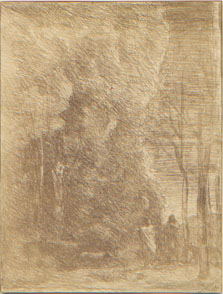
|
S. 223 x 166 mm
|
Dante et Virgile
Robaut 3195,
Delteil 76, Melot 76
glass print (cliché-verre)*, 1858, on
fine cream wove paper (papier salé),
the only known state, a very fine
brownish-bistre impression, trimmed as usual to the borderline (the
image is of course complete), from the very rare first printing by
Charles Desavary;
mounted on hinges, in excellent condition
|
Provenance: Constant
Dutilleux (see note here below with his wetstamp, recto, lower right (Lugt 2914)
This fine print of Corot's
mature style depicts an Italianate landscape, staging the two poets,
lower right, at the edge of a forest.
Corot rarely illustrated
literary themes, but he clearly has read Dante's Divina
Commedia:
The First Canto opens "in a
dark wood" ("per una selva oscura")
where Dante has lost his way, and goes on to describe three fearsome beasts confronting him, a panther ("una lonza"), a lion ("un leone"), and a she-wolf ("una lupa"), driving him back;
fleeing ever downward, he makes out an apparition, to whom he cries for
pity
("Miserere di me"), not
knowing if it is a shade or a man...
Worked up in sketchy
refinement, the artist's graphic handling in this glass print renders
the subject
with a vibrant rhythm that oscillates between
realism, classicism, and romanticism.
It should further be
noted that there were no later printings of this work by either
Bouasse-Lebel or Sagot-Le Garrec.

* Technically speaking
the glass print (or cliché verre) was then an innovative
photographic medium invented by Constant Dutilleux and his son-in-law,
Charles Desavary. Taking a plate of glass coated with an opaque
layer of collodion, the artist would draw into the ground with
a sharp stylus, and then place the plate (as a sort of negative)
onto a photosensitive sheet of paper that, once exposed to light,
would be developed like a photograph. Corot first discovered this
process on a trip to visit his friends in Arras, in 1853, and went on
to create more
than 60 glass prints over the next 20 years.
This technique, given
the variables involved in preparing the paper, determining exposure
times, etc., resulted in a range of effects that were far more
difficult to control than those of more conventional printmaking
media. And it may even be surmised that Corot was intrigued by
such variety, which in turn fed his creative endeavour.
N.B. A fusain sketch of Dante et Virgile,
now in the Musée du Louvre (RF3354), was made by Corot in the spring of
1859 during another visit to Dutilleux in Arras, in order to give his
friend an idea of the picture of the same subject, then being shown in the Salon de 1859 (see Claude Bouret et
al., Corot, le Génie du Trait,
BNF, 1996, n° 96, 97, and 152).


